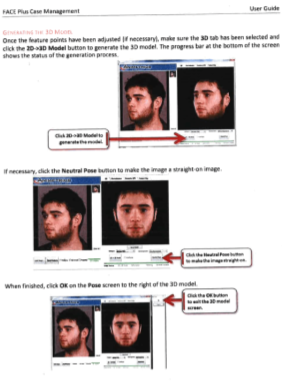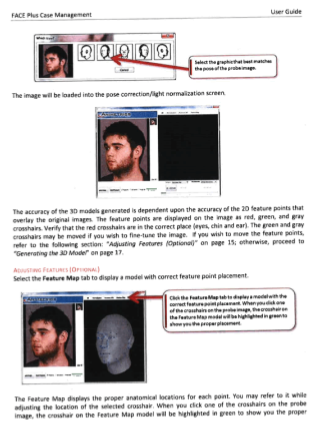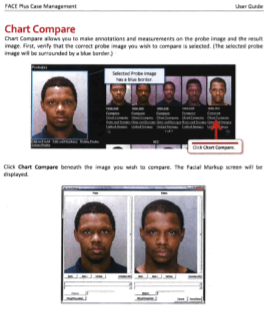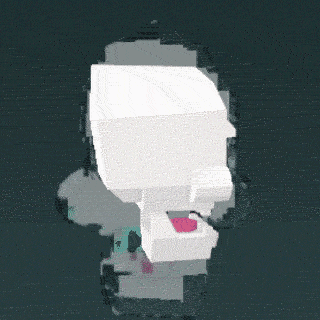


Instruction from a Dataworks manual obtained via FOIA. First, the uploaded image is edited and marked up. Then an algorithm searches for potential matches from a database.

Biometrics is the use of physical markers like facial features, fingerprints, or gait for identification purposes. The Chicago Police Department is known to use fingerprint analysis and facial recognition technology to attempt to identify criminals.
CPD has released very little information as to how they employ facial recognition technology, although it seems that most of the relevant infrastructure and personnel are located in the Crime Prevention and Information Center (CPIC), located in the Public Safety Headquarters. CPIC is part of a network of over 80 fusion centers around the country, which were created in the wake of 9/11 to gather and share counterterrorism intelligence. Fusion centers have come under a great deal of scrutiny for violating the First Amendment, resisting accountability, and failing to improve counterterrorism efforts.
Still images from cameras in Chicago's camera network can be analyzed with facial recognition technology.
FOIA documents indicate that CPD spent $63,000 on mobile fingerprint scanners in 2013. It is unclear whether CPD has continued to purchase fingerprint scanning technology since then, although they have received proposals for fingerprint scanners from NEC Corporation, which would have cost up to $5 million.
Documents obtained via FOIA by LPL reveal that in 2013, CPD paid $2.3 million to upgrade its camera network and obtain a custom built facial recognition system from Dataworks Plus, funded via a grant from the TSA. These documents also indicate that CPD continued to pay around $100k a year to Dataworks until at least 2016. It is unclear how CPD has been using FRT since then.
In 2020, CPD signed, in secret, a $49,875 contract to use facial recognition technology developed by Clearview AI. Clearview's software identifies individuals by comparing them to billions of facial images that the company scraped from social media platforms, significantly expanding police's ability to identify individuals. CPD ended its contract with Clearview in May 2020.
If CPD officers want to identify an individual in footage from CPD’s camera network or anywhere else, Dataworks’s platform enables them to crop and mark up a face from an image, and analyze CPD’s mugshot database for potential matches through algorithms developed by NeoFace and Cognitec.
In 2014, CPD claimed that they used facial recognition to identify and arrest a robber, yet investigative reporting revealed that it is unclear how facial recognition was used in this case. CPD released documents pursuant to a FOIA request by LPL that alluded to the use of facial recognition technology in a few investigations, although it is unclear how often CPD has used the technology or how successful it has been.
Although companies and industry groups boast of the technology’s accuracy, facial recognition systems do not yet seem to be accurate enough to consistently identify individuals across various demographic groups. Even Detroit’s Police Chief has said that his department’s facial recognition software is inaccurate 96% of the time.
CPD’s Latent Print Unit (LPU), which examines fingerprints from crime scenes, has come under a great deal of scrutiny for having opaque, ineffective, and outdated practices. An external review found that LPU examiners lack adequate training, and that the unit has not kept up with reformed standards in the field. Thus, the Cook County Public Defender’s Office usually motions for courts to ignore testimonies from CPD’s fingerprint analysts.
Illinois' Biometric Information Protection Act (BIPA), passed in 2008, is one of the strongest biometric privacy laws in the country, requiring companies to obtain written consent from an individual to collect their biometric data, and also to store and dispose of that data securely. In 2019, LPL and our partner organizations helped win a supreme court case to protect BIPA. While private companies like Clearview and Facebook, which recently settled a case for $650 million, are subject to BIPA, public agencies such as the police are not.
One of the many concerns that civil rights and privacy activists have raised is related to its inaccuracy. Studies have found that most facial recognition algorithms are significantly worse at identifying people of color than white people. There have already been cases of African American men being falsely identified by police facial recognition algorithms.
In addition, Chicago’s use of facial recognition is particularly worrying due to its secrecy, as it is unclear how CPD has been using the technology. CPD issued a directive for facial recognition technology in 2013 and hasn't updated it since, even though they promised to in 2016. The fact that this technology is primarily deployed out of the CPIC, which is quite opaque and collaborates with federal authorities, does not help. CPIC has no privacy policy in place for its use of facial recognition technology, even though this is required under DHS's funding requirements.
Due to these and other concerns surrounding facial recognition technology, LPL is leading the #PressPauseChicago coalition, which aims to ban facial recognition in Chicago.



Instruction from a Dataworks manual obtained via FOIA. First, the uploaded image is edited and marked up. Then an algorithm searches for potential matches from a database.